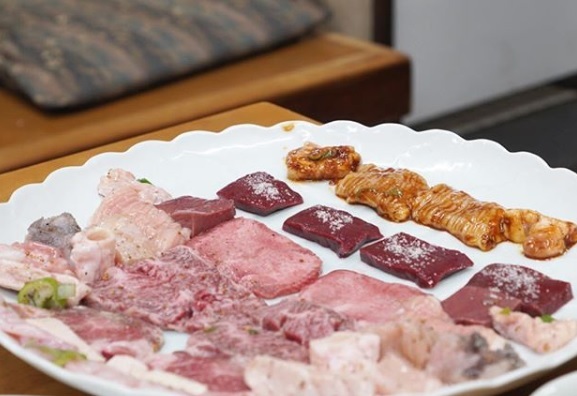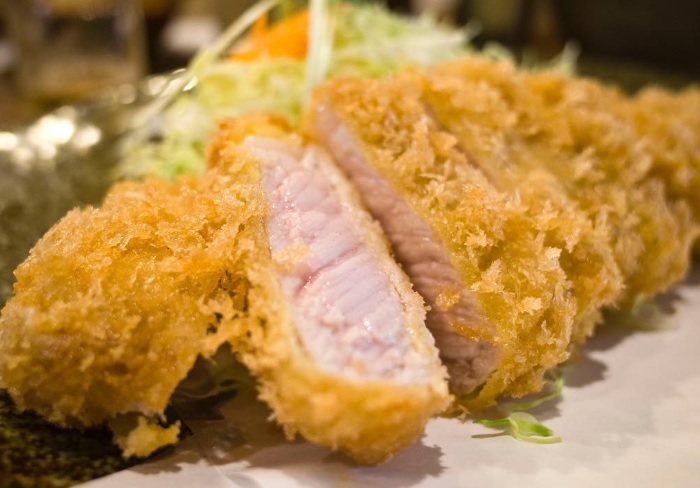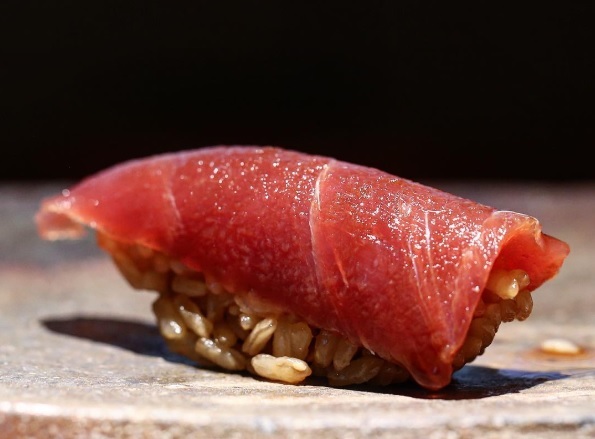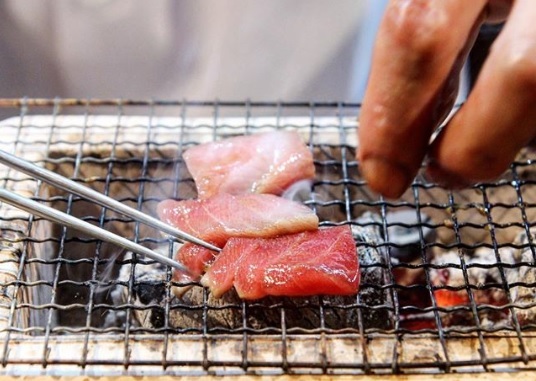Newest Information for 2018 on Tokyo's Sushi Restaurants
While much of the spotlight tends to go to young sushi chefs who have studied at famous sushi restaurants, 2018's sushi scene in Tokyo is also bursting with new locations of popular restaurants and new restaurants from people who worked at Michelin 3-star restaurants.
This page features our quick compilation of noteworthy new restaurants that anyone who considers themselves a foodie should visit.
If any of these restaurants catch your eye, be sure to go for a visit before they become too popular!
1. Hakkoku
This hot sushi restaurant was opened in February of 2018 by Hiroyuki Sato, the former feature chef of "Sushi Tokami."
Customers from around the world have come to Hakkoku in search of sushi made by world-famous chefs.
The unique course meal here begins with a hand roll (temaki-zushi) made with meat from the base of the bluefin tuna's head, something that he came up with during his time at "Tokami," and the iconic deep brown and very tart sushi rice made with plenty of red vinegar is present here at "Hakkoku" as well.
If you're looking to taste some of the most cutting-edge sushi in Tokyo, the striking omakase course here at that includes over 30 pieces of nigiri made with the finest of ingredients is a must-try.
★Hakkoku
Address: 3F 6-7-6 Ginza, Chuo-ku, Tokyo
Phone: 03-6280-6555
Hours:
[Lunch] 11:30-14:30
[Dinner] 17:00-22:00
Budget: 30,000~ yen
Closed: Sundays, holidays
Reservations: Make reservations at least 2 months before desired date
Credit cards accepted (VISA)
2. Sushi Namba Midtown Hibiya
This hot sushi restaurant is the newly opened relocation of super-popular sushi restaurant "Sushi Namba" in Tokyo's Asagaya to a new location in "Hibiya Midtown."
"Sushi Namba" gained popularity due to its reasonable prices for plenty of delicious side dishes and nigiri, but since moving to Hibiya it has been shifting its focus to high quality ingredients and nigiri sushi. Supposedly the owner's intent is to become a contender for the top sushi restaurant in Tokyo, often dominated by restaurants in Ginza.
If you're a foodie who has an affinity for sushi, you'll absolutely want to try the nigiri served by this next generation of "Namba," where the rice and fish are carefully kept to precise temperatures.
(Incidentally, the original location in Asagaya has been taken over by the number one assistant chef, and it is still operating under the name "Sushi Namba.")
★Sushi Namba Midtown Hibiya
Address: 3F Tokyo Midtown Hibiya 1-1-2 Hibiya, Chiyoda-ku, Tokyo
Phone: 03-6273-3334
Hours:
[Lunch] 12:00-15:00
[Dinner] 19:00-23:00
Budget: 30,000~ yen
Closed: Mondays, 1st Tuesday of the month
Reservations: https://www.omakase-japan.jp/en/stores/10004
Credit cards accepted
3. Sushi Tsubomi
This freshly-opened new restaurant was produced by "Sushi Saito," Japan's most popular sushi restaurant.
While saying it was "produced" by Saito may sound odd, but both the ingredients used and the chefs at Sushi Tsubomi are from "Sushi Saito," so you can easily enjoy high-quality sushi that's very similar to that served at the Michelin 3-star restaurant. (Incidentally, the current chef at Sushi Tsubomi is Makoto Maruyama, who served as the head of "Sushi Saito Kuala Lumpur.")
The well-shaped nigiri here at Sushi Tsubomi beautifully resemble those made by Takashi Saito, known as Japan's best sushi chef to some.
Like "Sushi Saito" in Roppongi and "Sushi Saito Bekkan" (another location of Sushi Saito in Roppongi) run by Chef Hashiba, it's only a matter of time until it will be hard to get reservations at Sushi Tsubomi.
★Sushi Tsubomi
Address: 1-21-26 Higashiyama, Meguro-ku, Tokyo
Phone: 050-5595-6314
Hours: 18:00-23:00
Budget: 20,000-29,999 yen
Closed: Wednesdays
Credit cards accepted (VISA, MASTER, JCB, AMEX, Diners)
4. Sakita
This sushi restaurant, opened by a chef who has worked at famous restaurants "Kyubey" and "Nakajyo," has become a super hot topic.
While Sakita is tucked away in a suburban residential area, it's packed daily with die-hard sushi fans who have heard about its offerings.
The dinner omakase course made by the owner, who used to work as a broker at Tsukiji Market, is overflowing with delicious pieces for just 15,000 yen.
Listening to the chef, known to some as the "fish professor," talk about his extensive knowledge while enjoying sushi made with high-quality ingredients like white horsehead, bluefin tuna, and Yezo abalone is truly one of life's pleasures.
If you're looking for delicious sushi at a reasonable price, don't let the travel away from the city center stop you from visiting Sakita at least once!
★Sakita
Address: 1-9-17 Shimorenjaku, Mitaka-shi, Tokyo
Phone: 0422-71-3133
Hours: 18:00~
Budget: 15,000-19,999 yen
Closed: Tuesdays
Credit cards accepted (VISA, MASTER, JCB, AMEX)
5. Sushi Mizukami
This sushi restaurant was opened by a chef who for a long time served as the right-hand-man of Chef Jiro Ono at "Sukiyabashi Jiro Roppongi Store."
There are two types of dinner courses available: "Nigiri only" for 20,000 yen, and "sides+nigiri" for 25,000 yen.
The flavor of the sushi rice, perfectly tart from the rice vinegar used, is truly a worthy successor to "Jiro."
Of course, tuna and abalone are served, but it's also a delight to find delicious renditions of traditional Edo-mae staples like gizzard shad, giant clam, clam, and anago here as well.
Currently the owner wishes to continue to faithfully recreate similar sushi as he did at "Jiro," but he has stated that, in the future, he wishes to gradually branch out and add some of his own originality.
This is an excellent restaurant to visit if you wish to try Jiro-styled sushi.
★Sushi Mizukami
Address: 3-8 Ichibancho, Chiyoda-ku, Tokyo
Phone: 03-3230-0326
Hours:
[Lunch] 11:30-14:00
[Dinner] 17:30-21:00
Budget: 30,000~ yen
Closed: Sundays
6. Kizaki
This newly-opened sushi restaurant is owned by a chef who came from "Tokami," a Michelin one-star restaurant in Ginza that is even popular with overseas tourists.
The lunch course, which begins with Tokami's signature hand roll (temaki-zushi) made with meat from the base of the bluefin tuna's head, is a bargain with 15 nigiri for just 12,000 yen.
The brown sushi rice, seasoned and colored with red vinegar, may look strong, but actually has a gentle and mild flavor, the perfect complement to the bluefin tuna purchased from "Yamayuki" at Tsukiji.
Another plus to Kizaki is that, unlike most sushi restaurants, you can bring your children along with you (however, this is available only on Sundays).
This is absolutely a restaurant to keep your eye on in Tokyo, where new restaurants are constantly opening and competition runs fierce as the world's #1 sushi hotspot, thanks to its unique position to draw attention in.
★Kizaki
Address: 5F 3-21-10 Akasaka, Minato-ku, Tokyo
Phone: 03-6807-4110
Hours:
[Lunch] 12:00-14:00
[Dinner] 18:00-23:00
Budget: 30,000~ yen
Closed: Mondays
Credit cards accepted (VISA, MASTER, JCB, AMEX, Diners)
7. Sushi Shinsuke
This sushi restaurant was opened in December of 2017 in Azabu-Juban, Tokyo's premier gourmet area, by a chef who has worked at popular Ginza restaurant "Sushi Ryusuke" and Hawaii restaurant "Onodera."
Their lunch and dinner options consist exclusively of a 20,000 yen omakase course.
The side dishes crafted by the 34-year-old chef, who has experience working in traditional Japanese restaurants, are exquisite, and it's easy to get lost in sampling the selection of over 30 different types of sake.
The sushi rice here has a sharp flavor, seasoned with very little sugar and taking a strong amount of tartness from the vinegar, and it pairs beautifully with the quality fish from Tsukiji Market's "Yamayuki."
Another plus is that the owner can speak English thanks to his experience in restaurant service, so foreign customers can visit worry-free and enjoy the experience.
★Sushi Shinsuke
Address: 2-19-7 Azabu-Juban, Minato-ku, Tokyo
Phone: 03-6809-6716
Hours :17:00-23:00
Budget: 20,000-29,999 yen
Closed: Never
Register account first.
Register










Comments 5
5
guest
@guest: I went last month and paid 28k and that is after adding 2 additional pieces of uni. Did you add on additional pieces? I think after adding additional pieces, the price tend to increase tremendously and well uni isn't exactly the cheapest thing in the world.
Leo Saito
chief editor, TokyoTableTripOut of several new sushi restaurants that have sprung up, I have carefully selected seven that are particularly noteworthy to feature here. Go ahead and book a table to dine at one while reservations are still easy to get!
guest
@guest: how much did u pay for Takamitsu? While I had an excellent meal there I can’t say the CP is off the charts, not even close. I paid 30k btw. Is this pricing so common nowadays that the it is considered Off the charts CP.
guest
If I can have only chance for one sushi restaurant, would u pick Hakkoku or Hashiguchi in Asakasa as your personal choice? Thank you so much for all helpful info.
guest
Hi Leo-san,
I just discovered your blog and would to seek your advise regarding some restaurants.
How would you compare the experience at Sushi Inomata and Sushi Shinsuke, in terms of taste and value?
You recommend both restaurants, we are thinking which one to try as we have 1 sushi slot left. We have Sushi Takamitsu booked as well. Or is there any other restaurant you would recommend?
We've only been to Sushiya and Sushi Taku in the past. Would really appreciate your kind advise and thoughts.
Also, do you have any recommendations for nice shabu shabu and yakiniku?
We've been Imafuku a couple of times and I really enjoyed it.
But since we've been there a few times, was thinking of trying something else?
How does Imafuku compare with Tokyo Niku-Shabu-ya which you also recommend for Shabu shabu? In terms of food and value.
As for yakiniku, we tried Yoroniku and Namaiki. We actually enjoyed Namaiki for the food and good value.
Besides the two, do you have recommendations?
What do you think of Yakiniku Jambo versus Ushigoro Ginza.
We look forward to hearing from you :)